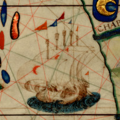File:Javanese jong in Indian Ocean, from Miller Atlas of 1519.png
Javanese_jong_in_Indian_Ocean,_from_Miller_Atlas_of_1519.png (311 × 243 pixels, file size: 196 KB, MIME type: image/png)
Captions
Captions
| The image contains one or several undisputed inaccuracies.
It should not be used to illustrate or provide information about the subject, but may be kept in order to provide the basis for a corrected image. If you disagree that it may be useful for this purpose feel free to request deletion. |
Note: This description has been identified as biased or incorrect.
| References for this description (or part of this) or for the depiction in the file are not provided. |
Summary
[edit]| DescriptionJavanese jong in Indian Ocean, from Miller Atlas of 1519.png |
English: Cropped portion of Indian Ocean, showing 2 large ships, identified as jong (Javanese junk), one is a 6-masted ship viewed from aft, the other is a 7-masted ship. It showed inaccuracies with the description of the jong of the time. The number of mast and sail suggest a size of 1000-2000 tons deadweight, which could be attributed to jongs hailed from Java or Sunda. The image is clearly an attempt to depict a large Javanese or Sundanese junk, probably referencing to large Majapahit jong of the 14-15th centuries or the single Pati Unus junk of late 1512 - January 1513. In the 16th century, average deadweight of jongs was 400-500 tons, they were equipped with 4 masts. Since there are crescent moon symbols that represent Islam, these jongs must be hailed from the Muslim area in Java, probably owned by the Demak Sultanate of Central Java (the kingdom of Sunda wasn't Islamized yet). The ships are probably drawn as a reference to Pati Unus' flagship (2000 tons deadweight) that was used to attack Portuguese Malacca in 1513.
Bahasa Indonesia: Bagian terpotong dari peta Laut Cina, menunjukkan 2 kapal besar, diidentifikasi sebagai jong (jung Jawa), satu kapal yang dilihat dari belakang bertiang 6, dan yang lainnya adalah kapal bertiang 7 (bisa lebih karena layarnya menghalangi tiang bagian depan). Gambar ini menunjukkan ketidakakuratan dengan deskripsi jong pada waktu itu. Jumlah tiang dan layarnya menunjukkan ukuran bobot mati 1000-2000 ton, yang dapat dikaitkan dengan jong yang berasal dari Jawa atau Sunda. Gambar tersebut jelas merupakan upaya untuk menggambarkan sebuah jung besar Jawa atau Sunda, mungkin merujuk pada jong Majapahit besar abad 14-15 atau jung tunggal Pati Unus akhir tahun 1512 - Januari 1513. Di abad ke-16 bobot mati rata-rata jong adalah 400-500 ton, mereka dilengkapi dengan 4 tiang layar. Karena ada simbol bulan sabit yang mewakili Islam, jong ini pasti berasal dari daerah muslim di Jawa, kemungkinan dimiliki Kesultanan Demak di Jawa Tengah (Kerajaan Sunda belum masuk Islam). Kapal-kapal tersebut kemungkinan digambar sebagai rujukan kepada kapal Pati Unus (berbobot mati 2000 ton) yang digunakan untuk menyerang Malaka Portugis pada tahun 1513. |
| Date | |
| Source | Lopo Homem-Reineis Atlas or Miller Atlas |
| Author | Lopo Homem, Pedro Reinel and Jorge Reinel illustrated by miniaturist António de Holanda |
| Other versions |
Similar ships from the same map: |
Licensing
[edit]| Public domainPublic domainfalsefalse |
|
This work is in the public domain in its country of origin and other countries and areas where the copyright term is the author's life plus 100 years or fewer. This work is in the public domain in the United States because it was published (or registered with the U.S. Copyright Office) before January 1, 1929. | |
| This file has been identified as being free of known restrictions under copyright law, including all related and neighboring rights. | |
https://creativecommons.org/publicdomain/mark/1.0/PDMCreative Commons Public Domain Mark 1.0falsefalse
File history
Click on a date/time to view the file as it appeared at that time.
| Date/Time | Thumbnail | Dimensions | User | Comment | |
|---|---|---|---|---|---|
| current | 07:32, 3 November 2019 |  | 311 × 243 (196 KB) | Verosaurus (talk | contribs) | {{Information |description ={{en|1=Cropped portion of Indian Ocean, showing 2 large ships, identified as jong, one is a 6-masted ship viewed from aft, the other is a 7-masted ship. Since it's showed inaccuracies with the description of Malay junk of the time, the image is clearly an attempt to depict a large Malay junk.}} |date =1519 |source =Lopo Homem-Reineis Atlas or Miller Atlas |author =Lopo Homem, Pedro Reinel and Jorge Reinel illustrated by miniaturist António... |
You cannot overwrite this file.
File usage on Commons
The following 7 pages use this file:
File usage on other wikis
The following other wikis use this file:
- Usage on en.wikipedia.org
- Usage on fr.wikipedia.org
- Usage on id.wikipedia.org
- Usage on ms.wikipedia.org
- Usage on uk.wikipedia.org
Metadata
This file contains additional information such as Exif metadata which may have been added by the digital camera, scanner, or software program used to create or digitize it. If the file has been modified from its original state, some details such as the timestamp may not fully reflect those of the original file. The timestamp is only as accurate as the clock in the camera, and it may be completely wrong.
| Horizontal resolution | 37.79 dpc |
|---|---|
| Vertical resolution | 37.79 dpc |
| File change date and time | 07:24, 3 November 2019 |


